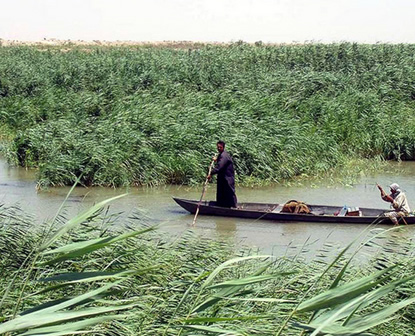 |
| Agricultural Revolution |
The agricultural revolution marked the transition by humans from hunting and gathering all their food to domesticating plants for food.
People first obtained their food by scavenging kills made by other animals, by hunting animals, and by gathering wild food plants. Between ten thousand and twelve thousand years ago, people began to use plants in new ways. Some scientists and historians call this period of time the "agricultural revolution".
Agricultural Beginnings
Before the 1960’s,many scientists and historians believed that hunter-gatherers abruptly switched from foraging to farming. Those who thought that agriculture arose quickly coined the term "agricultural revolution".
  |
They suggested that this revolution spread rapidly because it was a tremendous improvement over the old foraging lifestyle, with the availability of cultivated food sources far more dependable than those of wild sources.
Since the 1960’s, scientists and historians have challenged this view of agricultural beginnings. Later studies have shown that modern hunting-gathering societies have a remarkably sophisticated knowledge about native plants and plants’ life cycles.
Gatherers use a large number of plant species for food. Hunting and gathering cultures today do not have to plant seeds intentionally to keep from starving and most likely did not have to do so in the past.
Domesticated and Wild Plants
Domesticated plants are genetically distinct from their wild ancestors. Domestication involves processes by which a wild plant adapts to the needs of the farmer. The traits that make a plant desirable as a human food plant may not be ones that confer survival value on plants in their natural habitats and may actually be detrimental to the plant’s survival in the wild.
People who gathered wild plants looked for traits that made gathering easier and more profitable. They would have gathered grasses, for example, that had bigger seeds or plants, had more seeds or fruits or edible parts, or had seed heads that did not shatter easily. If seeds from such plants are the ones that were planted, accidentally or on purpose, their useful traits would be reinforced in successive generations.
The appearance of a domesticated plant in the archaeological record is the end result of generations of cumulative genetic transformations that might have taken hundreds or even thousands of years. Therefore, it becomes difficult to pick a single point in the past for any continent or geographic region that signals the beginning of an agricultural economy.
Geography of Agricultural Origins
 |
| Fertile Crescent |
The area of the Middle East called the Fertile Crescent (between the Tigris and Euphrates Rivers in what is now Iraq) seems to be the first area where formal agriculture began. The native grasses were highly productive.
Wild wheat and barley grew in dense stands and were valuable food sources before cultivation began. It was this use of gathered wild grasses for food that probably led to their early domestication.
Along with the grasses, complementary sources of protein were adopted, namely leguminous crops such as pea and lentil, and animals were domesticated. The plants that were domesticated in the Middle East include einkorn wheat, emmer wheat, bread wheat, barley, lentil, pea, vetch, the fava (or broad) bean, chickpea, lupine, and flax.
Agriculture originated in northeast China with the Yang Shao culture around six thousand years ago and spread quickly into Korea and Japan. Some of the plants brought under cultivation include barley, barnyard millet, common or broomcorn millet, foxtail millet (or foxtail grass), soybean, adzuki and mung beans, hemp, buckwheat, bottle gourd, Chinese cabbage, great burdock, lacquer tree, paper mulberry, and a number of fruit trees, including apricot, pear, peach, and plum.
In Southeast Asia, as well as the Pacific Islands and India, cultivated plants included sesame, the pigeon pea, eggplant, rice, sugarcane, bananas, plantains, coconuts, oranges, mango, Asian yam, betel nut, pepper, taro, bitter gourd, winter melon, snake gourd, luffa, mangosteen, durian, rambutan, breadfruit, and bamboo.
In Africa, plant domestication took place south of the Sahara Desert and north of the equator. Many crops were grown, including various kinds of millet, sorghum, okra, coffee, watermelon, several species of yam, African rice, cowpea, African oil palm, and cola nut. In Ethiopia, Ethiopian oats, coffee, enset, tef, noog, and chat were cultivated.
In Central America, archaeological evidence suggests that squash and pumpkins may have been cultivated before corn, especially in the Oaxaca region. In Oaxaca and Tamaulipas, along with squash and pumpkins, people were cultivating beans and bottle gourds, followed later by corn.
In the Tehuacán Valley of Central Mexico, corn, chile peppers, avocado, beans, amaranth, and foxtail grass were among the very earliest cultivated plants.
Cultivated plants either originating or cultivated early in South America include quinoa, white potato, peanut, cacao, jicama, lima bean, common bean, pineapple, chile pepper, papaya, sweet potato, yucca, and avocado. Tomatoes were cultivated in both Central and South America.
In North America, prior to the diffusion of the corn-squash-beans complex from the southwest after 1000 c.e., Indians of Eastern North America were cultivating a number of plants, including bottle gourd, erect knotweed, sumpweed, goosefoot, maygrass, little barley, and sunflower.
